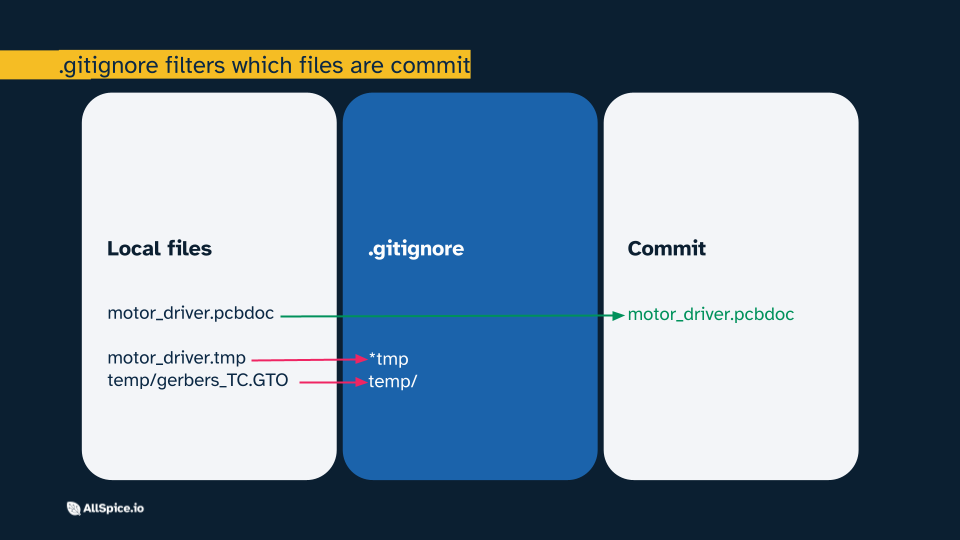Mastering .gitignore: Keep Your Git Repo Clean and Focused
In hardware development, as in software, your Git repository is your source of truth. But not everything in your working directory belongs in version control. That’s where .gitignore comes in.
This guide explains what .gitignore is, how it works, and how to use it effectively to manage your ECAD and documentation workflows in Git.

What is .gitignore?
.gitignore is a special file that tells Git which files or directories to exclude from tracking. While Git tracks changes to your version-controlled files, it ignores anything matched by rules in this file.
This is particularly useful for:
- Temporary files (e.g. auto-generated files from ECAD tools)
- Build artifacts
- IDE and OS metadata
- Local documentation or export folders
How Git Uses .gitignore
Git applies .gitignore rules recursively from the directory the file lives in. Typically, you’ll place a .gitignore file in your repository root, though you can also add directory-specific .gitignore files when needed.
Ignored files:
- Won’t appear in
git status - Won’t be added to commits
- Can still exist in your working directory for local use
Note: If a file has already been committed,
.gitignorewon’t remove it. You’ll need to delete it and recommit if you want it gone from version control.
How to Create a .gitignore File
- Create a file named
.gitignorein the root of your repository. - Add rules line by line.
Example:
# Ignore generated simulation files
*.out
*.log
# Ignore KiCad backup and autosave files
*.bak
*.tmp
# Ignore system files
.DS_Store
Thumbs.db
Each rule matches a file pattern or path. Patterns can include:
*(wildcard)/(for specific path)!(to negate a rule)
Example: Ignoring a Dedicated Folder Like _ignore/
A common pattern in hardware projects is to create a local dump folder for experiments, images, exports, or test scripts. You can name it _ignore/ to clearly signal its purpose.
To ignore the entire folder:
# Ignore all files in the _ignore directory
_ignore/
This tells Git to skip all content inside _ignore/, but still lets your team use it locally for sandbox files or temporary assets.
ECAD-Friendly .gitignore Examples
KiCad
*.bak
*.kicad_sch-bak
*.tmp
*.~* # temporary files
*.dcm
*.net
*.xml
*.cache/
Altium
__Previews/
History/
*.OutJob
*.PcbDocPreview
*.PrjPCBStructure
General Hardware Projects
# Output folders
build/
output/
*.zip
# Sim files
*.vcd
*.out
*.log
AllSpice-Hosted .gitignore Templates
We maintain curated .gitignore templates for common ECAD tools. You can use these as a starting point in your hardware projects:
You can include them directly in your repositories or adapt them to your tool-specific workflows.
Tips and Best Practices
-
Use comments: Document why certain patterns are ignored.
-
Keep it repo-specific: Don’t copy-paste
.gitignorefiles blindly; tailor them to your toolchain and workflow. -
Add exceptions with
!: Useful for keeping a README inside an ignored directory:_ignore/* !_ignore/README.md -
Use a global
.gitignorefor system-wide ignores: e.g. editor configs or OS files (~/.gitignore_global).
Wrapping Up
A thoughtful .gitignore file keeps your repository clean, focused, and easier for collaborators to work with. Whether you're managing a complex ECAD workflow or a simple schematic, understanding how to exclude noise from your version history is a key Git skill.
Want to dig deeper into Git workflows for hardware? Check out our articles on branching strategies, design review automation, and more on learn.allspice.io.